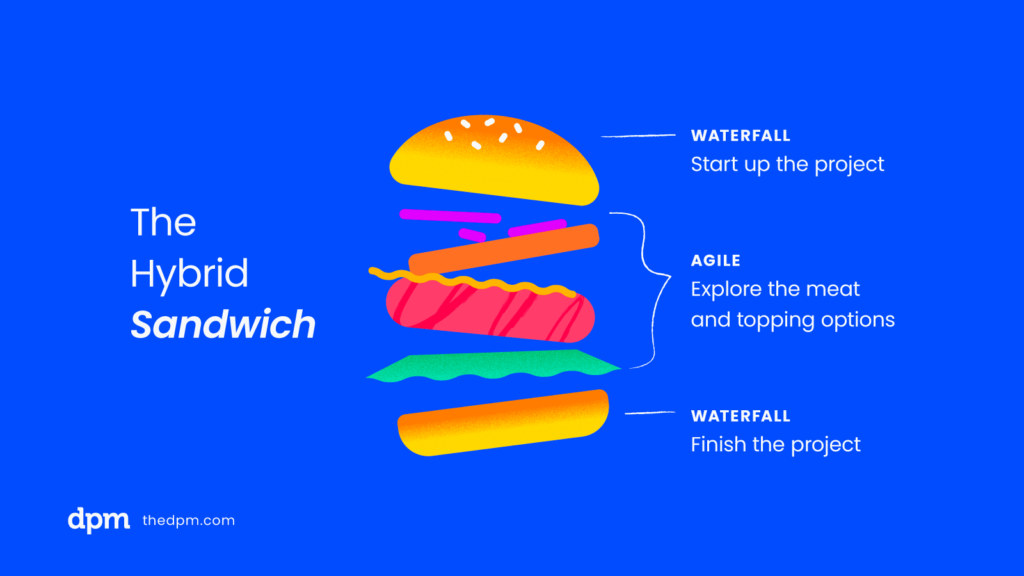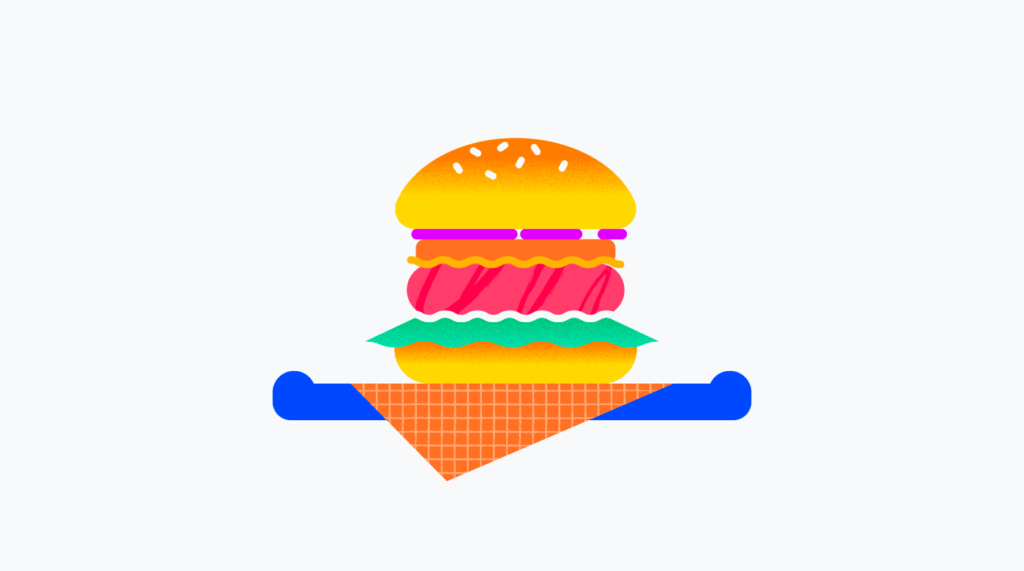Did you know that most agile projects in project and product management are secretly hybrid projects?
Let's dig into the differences between agile, waterfall, and hybrid. I’ll explain why most agile projects are really hybrid, and then I’ll introduce the ‘sandwich’ model.
What’s Agile Project Management?
Agile project management is an iterative project methodology that encourages being responsive and adapting to changes through the project life cycle.
It’s like building a creative new dish at a Michelin Star restaurant. It's all about iterative steps, delivering the ingredients bit by bit and tasting along the way until it's ready for the diners.
When I introduce the ‘sandwich’ below, you’ll see that agile is the middle component.
What’s Waterfall Project Management?
Waterfall, on the other hand, is more like cleaning up after a meal. The dishwasher knows how to clean up from lots of experience and can even daydream about their evening plans while mechanically getting the dishes cleaned and put away.
As defined in our article on waterfall, “waterfall project management is a linear type of project management that moves through distinct phases of work. These phases of work are dependent on the previous phase, so only one phase of the project can be worked on at a time.”
You will soon learn that the waterfall method is used at the two ends of the ‘sandwich’ (sometimes known as water-agile-fall).
What’s Hybrid Project Management?
There are a number of different agile and waterfall methods, such as Scrum and Scrumban for agile, and PRINCE2 and PMI PMBOK for waterfall. Let’s keep it simple and consider these as two major categories, agile and waterfall.
Hybrid project management is simply a combination of 2 or more methodologies (usually agile and waterfall) in the same project. Yes, one project, one budget.
Consider using a hybrid method when most of the following is true:
- Some requirements are predefined and others are not yet known
- You need iterative releases to obtain feedback, or to identify deeper or uncovered requirements
- The project has a start and end date, although the end date may be flexible
Why Most Agile Projects Are Really Hybrids
You might think you’ve gone fully agile, but here’s a common scenario I see play out on projects:
The project manager has a dedicated team that follows the Scrum method, which involves iterating through sprints. This is done during the project phases where the bulk of the actual project work is completed, such during design, build, and test phases. The Scrum team grabs targeted backlog items for iterations of sprints.
In parallel, the project manager, along with business analysts, directors, and other stakeholders are managing and executing non-sprint activities. They’re following standard processes they chose for the project, because they know exactly what needs to be done in project phases like initiate, plan, and project close.
Assuming the project is not iterating using agile approaches during every phase, including the up front planning (as opposed to a more agile approach to planning, like planning poker) and backend closing, then the project is really using a hybrid approach.
Introducing The Hybrid “Sandwich" Framework
Hybrid projects combine the best of both worlds. Let’s take a look at the structure of a project and identify when we will be using waterfall versus agile methods.
Most projects have a start, a middle, and an end. Consider the following common phases for a software implementation project:
- Start: Initiate, plan, design
- Middle: Build/sprints/tests
- End: Train, close
Let’s look at the burger analogy and figure out when to use Waterfall and when to use Agile.

The top bread slice
You've done it countless times when making a sandwich. You pick your favorite type of bread without thinking from past experience. You know which bakery has the best buns and it’s your go-to for every sandwich. You know what to expect, and it's comforting.
This top slice of bread represents your waterfall methodology for project initiation and planning. It's your known recipe. You know what to do to kick off the project, set up the charter, obtain an initial budget, etc. All is known, but of course you can tweak your process over time from lessons learned.
The juicy middle
Here's where the fun happens. You try different ingredients, flavors, and toppings. You have ideas about the meat or substitutes, different vegetables, and spices.
You never know what will work until you, or your diners, take a small bite. Maybe it's missing some kick, so you add onions and take a new bite. Keep experimenting until it tastes just right.
In the project, this juicy middle represents the agile part. It's where you bring ideas to life, iterate, seek feedback, and test until the total end solution becomes crystal clear with expected results.
The bottom bread slice
Again, like the top of the burger, finding the bread is as simple and repetitive as setting the dinner plate on the table.
This is the final stage of your project. You've been there, done that. You know the exact steps to get customer sign-off, tie up loose ends, and review lessons learned. Like the beginning of the project, this is a waterfall approach. You've got this part down to a science.
The Confusion Of Project Tools For Hybrid Projects
Many agile-labeled projects that are really hybrid use a mix of project tools. For example, the Scrum team who focuses on the iterative sections may use agile tools like Jira to manage sprints.
Meanwhile, project or program managers handling the waterfall part of initiation, planning, and budgeting may use a different tool like Microsoft Project or Excel.
This complexity of multiple tools for the same project is like trying to make one sandwich with two chefs in two different kitchens, rarely speaking with each other.
Even Scaled Agile Framework (SAFe), which is used for larger projects, uses a combined set of project tools: one type of tool (ex. Excel) for their pre-known methods for their program implement planning (a key event in SAFe) and another tool (ex. Jira) for their agile release train (the team building and delivering the work).
A Real ‘Sandwich’ Project Example
There are not many tools that are made for hybrid projects where you can combine waterfall and agile within the same project, utilizing the best features for both.
A good tool is one that can handle this ‘sandwich’ model: both waterfall and agile methods within the same project.
Consider searching for a tool where you can visually see the project phases of the ‘sandwich’ framework where the ends contain the waterfall phases with their activities in a process format and the middle agile phases contain their activities in a kanban board format, say, with sprint automation features.
This visualization is important for helping cross-team members quickly understand where their work is and for executives to get a real-time picture of what’s happening and where the bottlenecks are located.
As an example, the following video displays a hybrid ‘sandwich’ framework.
For Your Next Project, Think ‘Sandwich’
Before kicking off your next project, think twice before you call it a pure waterfall or a pure agile project. Ask yourself if your waterfall project could benefit from iterative development for a certain amount of time and scope.
Likewise, ask if your agile project does indeed have a finite time and budget and if it can leverage best practice processes and frameworks for part of the activities. If so, this is where the ‘sandwich’ can be the best approach.
As your organization embraces the ‘sandwich’ or other hybrid methodologies, you can still utilize your firm’s well-known processes, blueprints, and flexible frameworks.
Then just think of adding the juicy middle part of your project life cycle with an agile approach to help with flushing out the unknowns and building quick releases that provide feedback for next steps.
Enjoy your projects filled with innovating and delightful ingredients of agile activities sandwiched between the tried and true comforting bread slices that contain your best practice processes.
For more on hybrid methodologies, subscribe to The Digital Project Manager newsletter.


